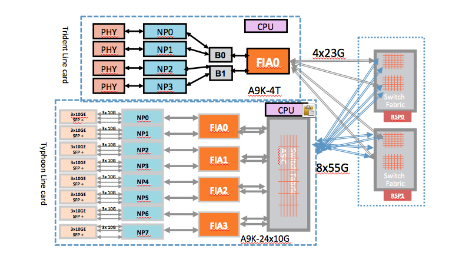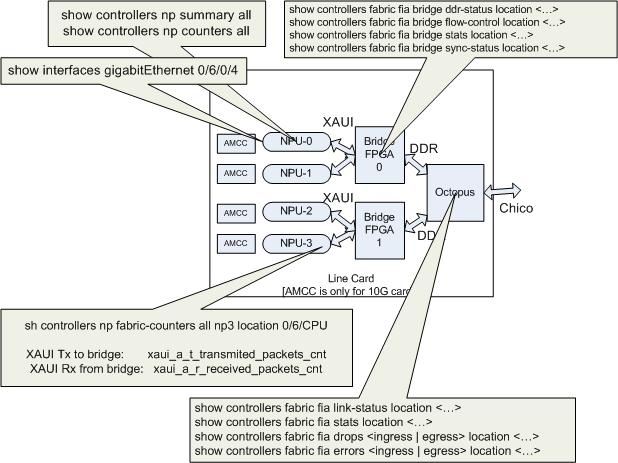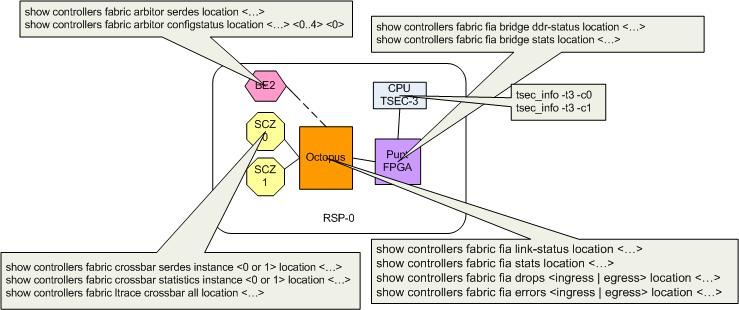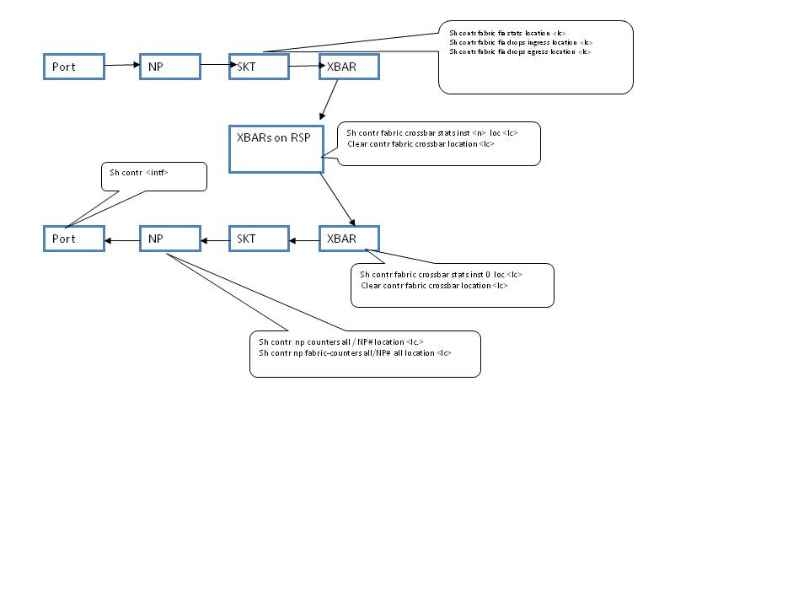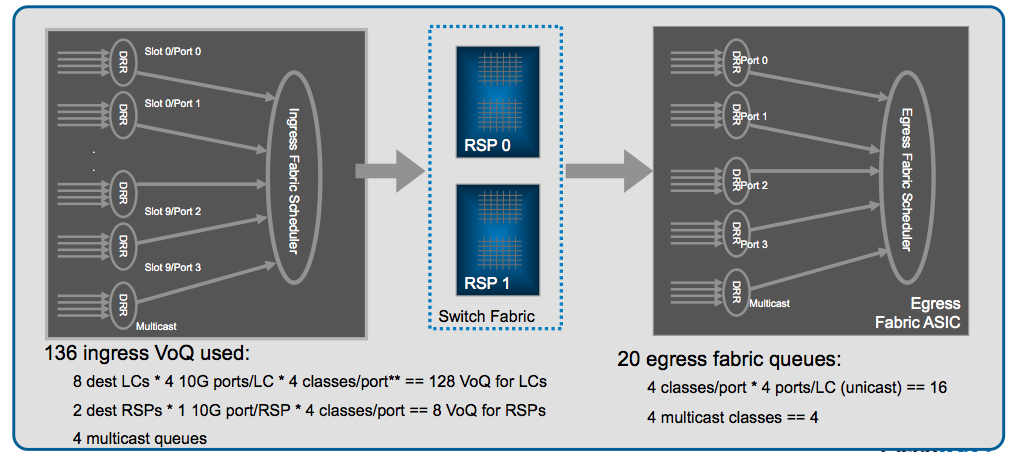- Cisco Community
- Technology and Support
- Service Providers
- Service Providers Knowledge Base
- ASR9000/XR: Understanding the Fabric and troubleshooting commands
- Subscribe to RSS Feed
- Mark as New
- Mark as Read
- Bookmark
- Subscribe
- Printer Friendly Page
- Report Inappropriate Content
- Subscribe to RSS Feed
- Mark as New
- Mark as Read
- Bookmark
- Subscribe
- Printer Friendly Page
- Report Inappropriate Content
on 03-10-2014 09:00 AM
- Introduction
- Before we start
- High level forwarding overview
- Troubleshooting fabric issues
Introduction
As you know troubleshooting the ASR9000 and XR is close to my heart. In this document we are going to expand on the fabric troubleshooting and operation.
Previous articles have expanded on the NP counters and NP troubleshooting. In this document we'll focus on the fabric specific.
Note this is just the first version of the document. I realize that some commands need to be explained better or what the output really means, but hopefully this gives a good impression to get started on the fabric.
Before we start
For this purpose it is important to know which type of linecard we have, a Trident or Typhoon.
the following cards are Trident based:
40G linecards: A9K-40GE, A9K-2T20G, A9K-4T, A9K-8T/4
80G linecards: A9K-8T, A9K-16T/8
Typhoon cards:
A9K-24x10, A9K-36x10, A9K-MOD80/160, A9K-2x100
This document does not pertain directly to the SIP700 linecard. Although the sip700 interfaces with its own FIA to the RSP fabrics like any other linecard would. Most of the commands for fabric verification can be used due to the fact that the SIP700 has the same FIA as the Trident linecard, but in this reference we are not specifically zooming in on the SIP700.
High level forwarding overview
The following picture gives an overview as to how packets are going from ingress to egress interface/linecard with the different forwarding asics in place.
The article https://supportforums.cisco.com/docs/DOC-15552 deepdived into the NP and its operation and verification.
In this article we're going to get a closer look at the FIA (Fabric interface Asic) and the Fabric itself.
One key thing to notice is here that:
- Trident does not have a fabric stage on the linecard whereas typhoon does.
- Typhoon does not have bridge asics.
For forwarding this doesn't really matter in terms of troubleshooting difference.
the reason why Trident has a bridge is because of the memory interfae on the NPU is XAUI whereas the FIA speaks DDR2, the bridge converts in between. It is a non blocking asic, but it can assist with backpressure when it receives it from the fabric.
The reason why Typhoon has a linecard fabric stage is to reduce the number of fabric links. As you can see, all FIA's connect with the fabric chips. High density linecards such as the 24x10 have 4 FIA's and the 36x10 has 6 of them. If all of these FIA's would directly connect to the RSP fabric chips, we'd run out of fabric links in the higher slot chassis such as the 9010.
The linecard fabric stage reduces the number of fabric links.
the 9922 and the 9911 have separate fabric cards. What is drawn here in the picture is the RSP440 (serving 55G per link for typhoon).
Using the 9922/11 with separate fabric cards is not a story changer either, we just have pulled the fab chips off the RSP and called them FC (fabric cards) and RP's (route processors). this gives a higher redundancy due to the ability to serve more fabric cards and higher fabric capacity per slot.
Troubleshooting fabric issues
Steps to debug packet drops
Please follow the below steps for fabric related issues:
Step 1) Look for active PFM alarms on LC as well as RSPs.
CLI: show pfm location all
Step 2) Check if your hardware FPGA versions are up-to-date
(see also Fabric hardware sanity section)
CLI: show controllers np summary all
CLI: admin show hw-module fpd all location all
Step 3) Follow the steps mentioned in packet drop debugging sections
(see Debugging Traffic Issues section).
Step 4) Exclude all "known" related fabric issues
%PLATFORM-PFM_NP-0-TMA_CLUSTER_PARITY
signifies a hardware error
%PLATFORM-DIAGS-3-PUNT_FABRIC_DATA_PATH_FAILED
signifies that diag packets from the RP have not been returned properly by the NP hardware. This can either be a software problem or a hardware problem. Check this article and reference for the latest detail to verify and troubleshoot this issue:
- https://supportforums.cisco.com/docs/DOC-32083
- http://www.cisco.com/c/en/us/support/docs/routers/asr-9000-series-aggregation-services-routers/116727-troubleshoot-punt-00.html
%PLATFORM-BRIDGE-3-NPU_0_SCH_MEMP_ERR_0
was seen on older bridge versions on Trident linecard, make sure the revision of the bridge FPGA is > 0.41 for 40G Trident linecards
and > 0.5 on the 80G Trident linecards
Visualization of the show commands and what they are checking
Legend:
- Octopus is the Trident Fabric Interface Asic
- NPU is Network Processing Unit, the Trident processor
- Chico is the name of the link between FIA and Fabric (on the RSP), using SERDES.
Legend:
- SCZ is Santa Cruz, the actual Fabric chip (there are 2 on the RSP4 and RSP440).
- Octopus is Fabric Interface ASIC. The RSP has one too for the punt path (remember that the RP/CPU is just another linecard to the fabric.
- BE is Bellagio, that is the Fabric Arbiter.
Data path packet drop debugging
The path a data packet travels is:
Incoming interface on LC--> NPU mapped to incoming interface on LC --> Bridge3 on LC --> FIA on LC --> Crossbar switch on RSP --> FIA on LC ---> Bridge3 on LC ---> NPU mapped to outgoing interface ---> Outgoing Interface
Clear all the counters:
Before beginning to debug traffic issues, please clear all counters and start afresh.
1) Clear Interface counters
RP/0/RSP0/CPU0:ROSH06_jetfire#clear counters all Thu Jan 1 04:17:32.676 UTC Clear "show interface" counters on all interfaces [confirm] RP/0/RSP0/CPU0:ROSH06_jetfire#
2) Clear NP counters
RP/0/RSP0/CPU0:ROSH06_jetfire#clear controller np counters all
3) Clear Fabric counters
To clear FIA counters on LC and RSP:
RP/0/RSP0/CPU0:ROSH06_jetfire#clear controller fabric fia location
To clear all fabric crossbar counters:
RP/0/RSP0/CPU0:ROSH06_jetfire#clear controller fabric crossbar-counters location
To clear bridge counters on LC
Check all the relevant traffic counters
After clearing counters, start traffic pattern that caused the drop.
1) Check the counters at input interface
RP/0/RSP0/CPU0:ROSH06_jetfire#show interfaces tenGigE 0/1/0/0 Thu Jan 1 01:10:01.908 UTC TenGigE0/1/0/0 is up, line protocol is up Interface state transitions: 1 Hardware is TenGigE, address is 001e.bdfd.1736 (bia 001e.bdfd.1736) Layer 2 Transport Mode MTU 1514 bytes, BW 10000000 Kbit reliability 255/255, txload 0/255, rxload 0/255 Encapsulation ARPA, Full-duplex, 10000Mb/s, LR, link type is force-up output flow control is off, input flow control is off loopback not set, Maintenance is enabled, ARP type ARPA, ARP timeout 04:00:00 Last clearing of "show interface" counters never 5 minute input rate 0 bits/sec, 0 packets/sec 5 minute output rate 0 bits/sec, 0 packets/sec 0 packets input, 0 bytes, 0 total input drops 0 drops for unrecognized upper-level protocol Received 0 broadcast packets, 0 multicast packets 0 runts, 0 giants, 0 throttles, 0 parity 0 input errors, 0 CRC, 0 frame, 0 overrun, 0 ignored, 0 abort 0 packets output, 0 bytes, 0 total output drops Output 0 broadcast packets, 0 multicast packets 0 output errors, 0 underruns, 0 applique, 0 resets 0 output buffer failures, 0 output buffers swapped out 1 carrier transitions
2) Check NPU counters
RP/0/RSP0/CPU0:ROSH06_jetfire#show controllers NP counters all location
Fields of interest in NPU counters from data path standpoint:
800 PARSE_ENET_RECEIVE_CNT -- Num of packets received from external interface 970 MODIFY_FABRIC_TRANSMIT_CNT -- Num of packets sent to fabric 801 PARSE_FABRIC_RECEIVE_CNT -- Num of packets received from fabric 971 MODIFY_ENET_TRANSMIT_CNT -- Num of packets sent to external interface
Run the following command to figure out NPU to interface mapping:
RP/0/RSP0/CPU0:ROSH06_jetfire#show controllers np ports all Thu Jan 1 02:18:48.264 UTC Node: 0/0/CPU0: ---------------------------------------------------------------- NP Bridge Fia Ports -- ------ --- --------------------------------------------------- 0 1 0 GigabitEthernet0/0/0/30 - GigabitEthernet0/0/0/39 1 1 0 GigabitEthernet0/0/0/20 - GigabitEthernet0/0/0/29 2 0 0 GigabitEthernet0/0/0/10 - GigabitEthernet0/0/0/19 3 0 0 GigabitEthernet0/0/0/0 - GigabitEthernet0/0/0/9
3) Check NPU - Bridge3 counters
RP/0/RSP0/CPU0:ROSH06_jetfire#show controllers np fabric-counters ? all all counters rx receive counters tx transmit counters RP/0/RSP0/CPU0:ROSH06_jetfire#show controllers np fabric-counters all ? all All NP instances np0 NP0 instance np1 NP1 instance np2 NP2 instance np3 NP3 instance np4 NP4 instance np5 NP5 instance np6 NP6 instance np7 NP7 instance RP/0/RSP0/CPU0:ROSH06_jetfire#show controllers np fabric-counters all np0 location <>
Using above CLI you can check the NPU-bridge rx/tx counters for each NPU on a given LC. The fields of interest here are:
xaui_a_t_transmited_packets_cnt -- Num pkt sent by NPU to bridge xaui_a_r_received_packets_cnt -- Num pkt sent by bridge to NPU
4) Check Bridge counters
RP/0/RSP0/CPU0:ROSH06_jetfire#show controllers fabric fia bridge stats location <> Thu Jan 1 02:23:34.163 UTC UC - Unicast , MC - Multicast LP - LowPriority , HP - HighPriority -------------------------------------------------------------------------------- FIA 0 ****** Cast/ Packet Packet Error Threshold Prio Direction Count Drops Drops -------------------------------------------------------------------------------- Unicast Egress Stats ******************** UC HP Fabric to NP-0 0 0 0 UC LP Fabric to NP-0 0 0 0 UC HP Fabric to NP-1 0 0 0 UC LP Fabric to NP-1 0 0 0 UC HP Fabric to NP-2 0 0 0 UC LP Fabric to NP-2 0 0 0 UC HP Fabric to NP-3 0 0 0 UC LP Fabric to NP-3 0 0 0 ---------------------------------------------------------------- UC Total Egress 0 0 0 Multicast Egress Stats ********************* MC HP Fabric to NP-0 0 0 0 MC LP Fabric to NP-0 0 0 0 MC HP Fabric to NP-1 0 0 0 MC LP Fabric to NP-1 0 0 0 MC HP Fabric to NP-2 0 0 0 MC LP Fabric to NP-2 0 0 0 MC HP Fabric to NP-3 0 0 0 MC LP Fabric to NP-3 0 0 0 --------------------------------------------------------------- MC Total Egress 0 0 0 Cast/ Packet Packet Prio Direction Count -------------------------------------------------- Unicast Ingress Stats ********************* UC HP NP-0 to Fabric 255 UC LP NP-0 to Fabric 0 UC HP NP-1 to Fabric 255 UC LP NP-1 to Fabric 0 UC HP NP-2 to Fabric 255 UC LP NP-2 to Fabric 0 UC HP NP-3 to Fabric 255 UC LP NP-3 to Fabric 0 ------------------------------------------------- UC Total Ingress 1020 Multicast Ingress Stats *********************** MC HP NP-0 to Fabric 0 MC LP NP-0 to Fabric 0 MC HP NP-1 to Fabric 0 MC LP NP-1 to Fabric 0 MC HP NP-2 to Fabric 0 MC LP NP-2 to Fabric 0 MC HP NP-3 to Fabric 0 MC LP NP-3 to Fabric 0 -------------------------------------------------- MC Total Ingress 0 Ingress Drop Stats (MC & UC combined) ************************************** PriorityPacket Error Threshold Direction Drops Drops -------------------------------------------------- LP NP-0 to Fabric 0 0 HP NP-0 to Fabric 0 0 LP NP-1 to Fabric 0 0 HP NP-1 to Fabric 0 0 LP NP-2 to Fabric 0 0 HP NP-2 to Fabric 0 0 LP NP-3 to Fabric 0 0 HP NP-3 to Fabric 0 0 -------------------------------------------------- Total IngressDrops 0 0
5) Check FIA counters
RP/0/RSP0/CPU0:ROSH06_jetfire#show controllers fabric fia stats location Thu Jan 1 01:51:37.097 UTC FIA:0 DDR Packet counters: ========================= From Bridge#[0] 510 To Bridge #[0] 510 From Bridge#[1] 510 To Bridge #[1] 510 FIA:0 SuperFrame counters: ========================= To Unicast Xbar[0] 19 To Unicast Xbar[1] 20 To Unicast Xbar[2] 0 To Unicast Xbar[3] 0 To MultiCast Xbar[0] 0 To MultiCast Xbar[1] 0 To MultiCast Xbar[2] 0 To MultiCast Xbar[3] 0 From Unicast Xbar[0] 19 From Unicast Xbar[1] 20 From Unicast Xbar[2] 0 From Unicast Xbar[3] 0 From MultiCast Xbar[0] 0 From MultiCast Xbar[1] 0 From MultiCast Xbar[2] 0 From MultiCast Xbar[3] 0 FIA:0 Total Drop counters: ========================= Ingress drop: 0 Egress drop: 0 Total drop: 0 RP/0/RSP0/CPU0:ROSH06_jetfire#show controllers fabric fia q-depth location 0/0$ Thu Jan 1 02:16:37.227 UTC FIA 0 ------ Total Pkt queue depth count = 0
6) Check Crossbar counters
RP/0/RSP0/CPU0:ROSH06_jetfire#show controllers fabric crossbar statistics instance 0 location Thu Jan 1 01:54:07.721 UTC Location: 0/RSP0/CPU0 (physical slot 4) Asic Instance: 0 Fabric info for node 0/RSP0/CPU0 (physical slot: 4) Dropped packets : mcast unicast +---------------------------------------------------------------+ Input buf bp pkts : 0 0 Output buf bp pkts : 0 0 Xbar timeout buf bp pkts : 0 0 HOL drop pkts : 0 0 Null POE drop pkts : 0 0
Puntpath packet drop debugging
RSP puntpath
The punt path is: Incoming Interface --> NPU --> LC CPU --> NPU --> Bridge3 --> LC FIA --> RSP Crossbar
--> Punt FPGA on RSP --> RSP CPU Local interface Ping path is: RSP CPU --> RSP FIA --> RSP Crossbar --> LC FIA --> LC CPU --> NP0 ---> LC FIA ---> Crossbar ---> RSP FIA ---> RSP CPU
To debug packet drop issues on any of the above paths:
1) Clear all packet counters as described earlier.
2) Start traffic.
3) Check traffic counters at each component
a) Check NPU counters for NPU mapping to interface and NPU0 for inject packet count. In case of NPU counters the following fields are of interest:801 PARSE_FABRIC_RECEIVE_CNT 820 PARSE_LC_INJECT_TO_FAB_CNT 872 RESOLVE_INGRESS_L2_PUNT_CNT 970 MODIFY_FABRIC_TRANSMIT_CNT 822 PARSE_FAB_INJECT_IPV4_CNTb) Check Fabric related counters.RP/0/RSP0/CPU0:UUT#show controllers fabric crossbar statistics instance 0 location 0/RSP0/CPU0 RP/0/RSP0/CPU0:UUT#show controllers fabric fia stats location 0/7/CPU0 RP/0/RSP0/CPU0:ROSH06_jetfire#show controllers fabric fia bridge stats location <>
c) Check Punt FPGA counters
d) Check Tsec counters
run tsec_info -t3 -c0
If pkts are lost inside fabric and not accounted in the fabric CLIs listed in the above diagram then check the output of following cmds
- sh contr fabric fia link-status location <lc>
- sh contr fabric fia trace location <lc>
- attach to lc#
- fiashell -c nzerrorcnt -l 1000 -i <skt intance #>
- fiashell -c intr -i <skt intance #>
Legend:
- SKT is Skytrain, the Fabric Interface ASIC for typhoon linecards
- XBAR is the Crossbar Fabric ASIC. Remember that Typhoon linecards have a fabric on the LC too.
Troubleshooting Back-pressure Issues
Although this is generally more QOS related, it is useful to understand backpressure and the verification of that within this fabric troubleshooting guide.
Every FIA has a set of VOQ's, this is a set of queues that represent a 10G entity in the system.
Every 10G entity (that means that 10x1G are represented with a single VOQ has different priority classes. Generally we see the default queue flowed off during backpressure scenario.
Only when the NPU is getting overloaded that is serving more BPS/BW or PPS then the circuits can handle, it will start to exert backpressure to the ingress Linecards. This is represented by a VOQ flow off on the FIA on that ingress linecard:
Zooming into the Fabric Interface Asic (FIA):
Identify the VOQ for an interface
RP/0/RSP1/CPU0:ios#show controllers pm interface tenGigE 0/5/0/0 loc 0/5/CPU0
Ifname(1): TenGigE0_5_0_0, ifh: 0xe000100 :
switch_fabric_port 0x17
VQI 23 is for interface ten0/5/0/0
NOTE: the SFP/Switch Fabric port is reported in HEX and represented in decimal (lovely  ) in the show fabric commands.
) in the show fabric commands.
Check if you are seeing FIA drops
RP/0/RSP1/CPU0:ios#show drops location 0/0/CPU0
=== snip ===
FIA 0 Drops:
----------------------------------------------------------------
Ingress Drops 287078960
Egress Drops 1
Total Drops 287078961
Ingress Generic Hard Drop-2 287078960
Egress Mcast RxFab Hdr-1 1
----------------------------------------------------------------
RP/0/RSP1/CPU0:ios#show controller fabric fia q-depth location 0/0/CPU0
FIA 0
VoQ | ddr | pri | pkt_cnt
------+-----+-----+---------
23 | 0 | 2 | 118
Total Pkt queue depth count = 118 Packets in the queue. Not good.
Useful commands to check for any hardware errors
1) Check for asic-errors for fia
Commands to check for asic errors for various fabric components.
show asic-errors arbiter 0 all location 0/RSP0/CPU0 show asic-errors crossbar 0 all location 0/RSP0/CPU0 show asic-errors fia 0 all location 0/1/CPU0
2) Check for pfm alarms
show pfm location <>
3) Checking link status
RP/0/RSP0/CPU0:ROSH06_jetfire#show controllers fabric fia bridge ddr-status loc <> Thu Jan 1 02:23:07.757 UTC FIA 0 ------ FIA DDR# Status -------- ------ 0 SYNCED 1 SYNCED RP/0/RSP0/CPU0:ROSH06_jetfire#show controllers fabric fia bridge sync-status loc <> Thu Jan 1 02:23:09.314 UTC FIA 0 ------ Bridge# NP# Status ------- --- ------ 0 0 SYNCED 0 1 SYNCED 1 2 SYNCED 1 3 SYNCED RP/0/RSP0/CPU0:ios#show controllers fabric fia link-status location 0/0/CPU0 Wed Jan 21 18:01:09.812 UTC Fia 0 to Arbiter sync status ARB 0 SYNCED ARB 1 SYNCED Fia 0 to Crossbar sync status Fabric Link 0 SYNCED Fabric Link 1 SYNCED Fabric Link 2 SYNCED Fabric Link 3 SYNCED Fia 1 to Arbiter sync status ARB 0 SYNCED ARB 1 SYNCED Fia 1 to Crossbar sync status Fabric Link 0 SYNCED Fabric Link 1 SYNCED Fabric Link 2 SYNCED Fabric Link 3 SYNCED 4) Check NP status and counters NP issues can cause packet drops in and outside fabric. NP(s) could be locked up or display error counters which may provide clues of the problem. Following is an example of NP lockup symptom: NP0, NP1 and NP2 all shows no non-zero counters, a good indication that they are locked up. RP/0/RSP0/CPU0:cork#show controller np counters all loc 0/4/CPU0 Sat Jan 3 18:25:44.795 EST Node: 0/4/CPU0: ---------------------------------------------------------------- Show global stats counters for NP0, revision v3 No non-zero data counters found Show global stats counters for NP1, revision v3 No non-zero data counters found Show global stats counters for NP2, revision v3 No non-zero data counters found Show global stats counters for NP3, revision v3 Read 15 non-zero NP counters: Offset Counter FrameValue Rate (pps) ------------------------------------------------------------------------------- 23 PARSE_FABRIC_RECEIVE_CNT 586 0 29 MODIFY_FABRIC_TRANSMIT_CNT 2 0 34 RESOLVE_EGRESS_DROP_CNT 578 0 70 RESOLVE_INGRESS_L2_PUNT_CNT 10 0 74 RESOLVE_LEARN_FROM_NOTIFY_CNT 544 0 80 RESOLVE_VPLS_MAC_MOVE_CNT 2 0 286 RESOLVE_MAC_NOTIFY_CTRL_DROP_CNT 544 0 287 RESOLVE_MAC_DELETE_CTRL_DROP_CNT 34 0 420 PARSE_FAB_MACN_RECEIVE_CNT 546 0 422 PARSE_FAB_MAC_DELETE_RECEIVE_CNT 18 0 423 PARSE_FAB_DEST_MAC_DELETE_RECEIVE_CNT 16 0 720 DIAGS 4 0 832 PUNT_STATISTICS 184 1 834 PUNT_DIAGS_RSP_ACT 3 0 836 PUNT_DIAGS_RSP_STBY 3 0 5) Check NP fabric counters This can be used to verify if packets are really transmitted out of NPs or if there are any errors between NP and FIA. Example: <span style="font-family: Courier New; color: #7a4707;">RP/0/RSP0/CPU0#sh controllers np fabric-counters all np0 loc 0/2/cpu0</span> <span style="font-family: Courier New; color: #7a4707;"> Node: 0/2/CPU0: ---------------------------------------------------------------- Egress fabric-to-bridge interface 0 counters for NP 0 INTERLAKEN_TX_PACKETS 0x00000000 00000000 INTERLAKEN_TX_BYTES 0x00000000 00000000 INTERLAKEN_TX_BAD_PACKETS 0x00000000 00000000 ------------------------------------------------------------- Egress fabric-to-bridge interface 1 counters for NP 0 INTERLAKEN_TX_PACKETS 0x00000000 02ce40bd INTERLAKEN_TX_BYTES 0x00000000 c20dff82 INTERLAKEN_TX_BAD_PACKETS 0x00000000 00000000 -------------------------------------------------------------</span> <span style="font-family: Courier New; color: #7a4707;"> Node: 0/2/CPU0: ---------------------------------------------------------------- Ingress fabric-to-bridge interface 0 counters for NP 0 INTERLAKEN_RX_PACKETS 0x00000000 00000000 INTERLAKEN_RX_BYTES 0x00000000 00000000 INTERLAKEN_RX_BAD_PACKETS 0x00000000 00000000 INTERLAKEN_RX_CRC_ERROR 0x00000000 00000000 INTERLAKEN_RX_ALIGNMENT_ERROR_0 0x00000000 00000000 INTERLAKEN_RX_ALIGNMENT_ERROR_1 0x00000000 00000000 INTERLAKEN_RX_ALIGNMENT_ERROR_2 0x00000000 00000000 INTERLAKEN_RX_ALIGNMENT_ERROR_3 0x00000000 00000000 INTERLAKEN_RX_ALIGNMENT_FAILURE 0x00000000 00000000 INTERLAKEN_RX_ALIGNMENT_FAILURE_1 0x00000000 00000000 INTERLAKEN_RX_ALIGNMENT_FAILURE_2 0x00000000 00000000 INTERLAKEN_RX_ALIGNMENT_FAILURE_3 0x00000000 00000000 INTERLAKEN_RX_BLK_TYPE_ERROR_AGGR 0x00000000 00000000 INTERLAKEN_RX_DIAG_CRC_ERROR_AGGR 0x00000000 00000000 INTERLAKEN_RX_WORD_SYNC_ERROR_AGGR 0x00000000 00000000 INTERLAKEN_LAST_CNT 0x00000000 00000000 0x00000000 00000000 ------------------------------------------------------------- Ingress fabric-to-bridge interface 1 counters for NP 0 INTERLAKEN_RX_PACKETS 0x00000000 03e3a8a4 INTERLAKEN_RX_BYTES 0x00000000 dec9c1ce INTERLAKEN_RX_BAD_PACKETS 0x00000000 00000000 INTERLAKEN_RX_CRC_ERROR 0x00000000 00000000 INTERLAKEN_RX_ALIGNMENT_ERROR_0 0x00000000 00000000 INTERLAKEN_RX_ALIGNMENT_ERROR_1 0x00000000 00000000 INTERLAKEN_RX_ALIGNMENT_ERROR_2 0x00000000 00000000 INTERLAKEN_RX_ALIGNMENT_ERROR_3 0x00000000 00000000 INTERLAKEN_RX_ALIGNMENT_FAILURE 0x00000000 00000000 INTERLAKEN_RX_ALIGNMENT_FAILURE_1 0x00000000 00000000 INTERLAKEN_RX_ALIGNMENT_FAILURE_2 0x00000000 00000000 INTERLAKEN_RX_ALIGNMENT_FAILURE_3 0x00000000 00000000 INTERLAKEN_RX_BLK_TYPE_ERROR_AGGR 0x00000000 00000000 INTERLAKEN_RX_DIAG_CRC_ERROR_AGGR 0x00000000 00000000 INTERLAKEN_RX_WORD_SYNC_ERROR_AGGR 0x00000000 00000000 INTERLAKEN_LAST_CNT 0x00000000 00000000 0x00000000 00000000 -------------------------------------------------------------
Related Information
The following documents are good references also:
Punt fabric datapath failures:
- http://www.cisco.com/c/en/us/support/docs/routers/asr-9000-series-aggregation-services-routers/116727-troubleshoot-punt-00.html
- https://supportforums.cisco.com/docs/DOC-32083
Quality of Service architecture for the ASR9000
- Mark as Read
- Mark as New
- Bookmark
- Permalink
- Report Inappropriate Content
I'm getting continuous fia drops:
FIA 0 Drops:
----------------------------------------------------------------
Total drop: 50
Egress drop: 50
Egress From Xbar Uc Crc-0 26
Egress From Xbar Uc Crc-1 24
Egress Uc dq pkt-len-crc/RO-seq/len error drp 50
----------------------------------------------------------------
(3 minutes later)
FIA 0 Drops:
----------------------------------------------------------------
Total drop: 65
Egress drop: 65
Egress From Xbar Uc Crc-0 32
Egress From Xbar Uc Crc-1 33
Egress Uc dq pkt-len-crc/RO-seq/len error drp 65
----------------------------------------------------------------
What are my resolution options?
- Mark as Read
- Mark as New
- Bookmark
- Permalink
- Report Inappropriate Content
If this is a Trident line card (i.e. no local crossbar ASIC on the line card), re-seat of the line card could help.
Otherwise, there were some SW fixes addressing FIA CRC errors.
If the XR release is recent and has all recommended SMUs, the line card should be RMAd.
hope this helps,
Aleksandar
- Mark as Read
- Mark as New
- Bookmark
- Permalink
- Report Inappropriate Content
This is on a 9001 running 4.3.4. Define 'recommended' SMUs for this release....
- Mark as Read
- Mark as New
- Bookmark
- Permalink
- Report Inappropriate Content
4.3.4 has quite a number of SMUs. Best to use the CSM to figure out which are the recommended ones.
Considering this is asr9001, most likely it'll have to be RMAd.
- Mark as Read
- Mark as New
- Bookmark
- Permalink
- Report Inappropriate Content
- Mark as Read
- Mark as New
- Bookmark
- Permalink
- Report Inappropriate Content
Both arbiters simultaneously receive the fabric grant request from a line card. Between the two arbiters there's a low level communication protocol through which they establish who is the active/standby arbiter. Only the active replies to grant requests.
- Mark as Read
- Mark as New
- Bookmark
- Permalink
- Report Inappropriate Content
and I owe you an answer from the other https://supportforums.cisco.com/document/59901/asr9000xr-understanding-qos-default-marking-behavior-and-troubleshooting#comment-11390111 ">discussion adam :
- each RP has 2 fabric chips, but both controlled by the rsp arbiter.
- each RP has an arbiter
- the grant allocation works as Aleks describes
- this is a great model that allows both RP's to know at any given time what the actual loads are, so that a failover is instantaneous and seamless
- there is no keepalive between the arbiters but the RP's have a "CPLD" asic and one of its functions is to track the other RP's state.
cheers
xander
- Mark as Read
- Mark as New
- Bookmark
- Permalink
- Report Inappropriate Content
Thank you very much,
Yes please, that’s why I assumed that both arbiters are getting the requests in order to know exactly the whole state of the system at any given time so the failover can be instantenious. Thank you very much for the clarification and confirmation.
Though it feels like the part where only the active Arbiter replies to grant requests is a bit incomplete.I’m afraid that the actual operation of arbiter is a bit ambiguous to me still. Since we know that the Arbiter in addition to relying fabric access requests and access grants actually also works with tokens, it has a number of tokens per VoQ as you thought me during our previous discussions.
Can I think of it as token bucket in QOS but instead of packets being represented by tokens here access grants being relied are represented by tokens So if the token bucket is empty ingress LCs will start queuing in a VOQ and eventually dropping starting from low priority packets When the arbiter permits the ingress FIA to send a (super)frame to specific VOQ, <- I guess that is when the active Arbiter relies access grant from egress FIA to ingress FIA that token is returned to the pool only when the egress FIA delivers the frames to egress NP.
But then how does the standby arbiter know the state of the token bucket please?
adam
- Mark as Read
- Mark as New
- Bookmark
- Permalink
- Report Inappropriate Content
the voq on the FIA has the scheduler. he is aware of what he is sending to the destination entity. that scheduling you could visualize with a token bucket.
the fabric is not so much scheduling but more piercing holes between ingress and egress destinations. fabric arbitration is not really the same as token scheduling in that regard. note also that both ariberts are seeing the request so they both know what is going on.
also note that on failure packets are drained of the active fabric while the standby is taking control.
note also finally that even if your RSP is in rommon, your fab is initialized and your fab will be used by the other rsp for forwarding.
xander
- Mark as Read
- Mark as New
- Bookmark
- Permalink
- Report Inappropriate Content
I see ok so I can visualize the FIA-to-Fabric scheduler as a token bucket per each VOQ.
Regarding fabric, yes please I’m aware of how various scheduler algorithms are used to converge on “maximal” match in least amount of iterations while avoiding starvation on any of the VOQs, all this in attempt to maximize the effective use of Fabric BW.
I’m just not sure how the central arbiter fits into the equation please?
As it appears the whole thing can work with just egress LC managing whom it will issue access grants.
adam
- Mark as Read
- Mark as New
- Bookmark
- Permalink
- Report Inappropriate Content
- Mark as Read
- Mark as New
- Bookmark
- Permalink
- Report Inappropriate Content
Below some additional triage for Fabric related issue
Find answers to your questions by entering keywords or phrases in the Search bar above. New here? Use these resources to familiarize yourself with the community:
